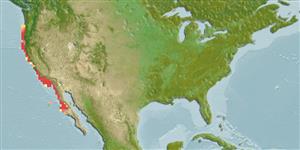Environment: milieu / climate zone / depth range / distribution range
Écologie
marin démersal; profondeur 49 - 201 m (Ref. 2850). Subtropical; 48°N - 27°N, 125°W - 113°W
Eastern Pacific: Copalis Head in Washington, USA to central Baja California, Mexico.
Length at first maturity / Taille / Poids / Âge
Maturity: Lm 28.0, range 25 - ? cm
Max length : 50.0 cm TL mâle / non sexé; (Ref. 2850); poids max. publié: 1.0 kg (Ref. 40637); âge max. reporté: 33 années (Ref. 39277)
Commonly found on soft bottom (Ref. 2850). Viviparous (Ref. 34817).
Eschmeyer, W.N., E.S. Herald and H. Hammann, 1983. A field guide to Pacific coast fishes of North America. Boston (MA, USA): Houghton Mifflin Company. xii+336 p. (Ref. 2850)
Statut dans la liste rouge de l'IUCN (Ref. 130435: Version 2024-2)
Menace pour l'homme
Harmless
Utilisations par l'homme
Pêcheries: commercial; pêche sportive: oui
Outils
Articles particuliers
Télécharger en XML
Sources Internet
Estimates based on models
Preferred temperature (Ref.
123201): 8.5 - 11.2, mean 9.7 °C (based on 13 cells).
Phylogenetic diversity index (Ref.
82804): PD
50 = 0.5000 [Uniqueness, from 0.5 = low to 2.0 = high].
Bayesian length-weight: a=0.01000 (0.00495 - 0.02022), b=3.09 (2.92 - 3.26), in cm total length, based on LWR estimates for this Genus-body shape (Ref.
93245).
Niveau trophique (Ref.
69278): 3.7 ±0.5 se; based on size and trophs of closest relatives
Generation time: 8.4 ( na - na) years. Estimated as median ln(3)/K based on 2
growth studies.
Résilience (Ref.
120179): Faible, temps minimum de doublement de population : 4,5 à 14 années (tmax=33; tm=6;).
Prior r = 0.20, 95% CL = 0.13 - 0.30, Based on 1 full stock assessment.
Fishing Vulnerability (Ref.
59153): High vulnerability (57 of 100).
